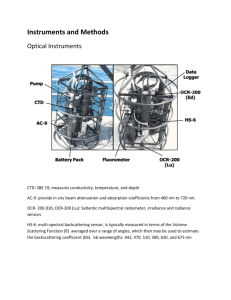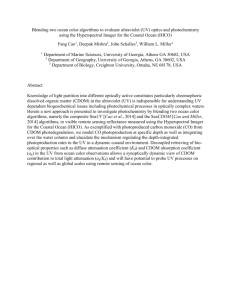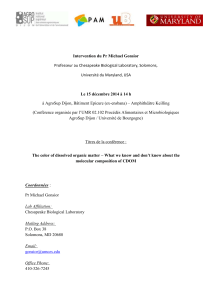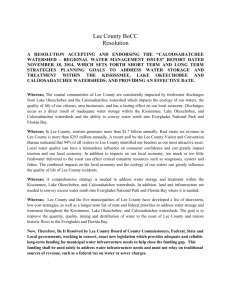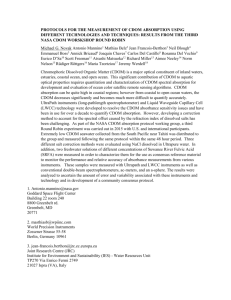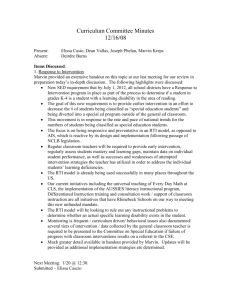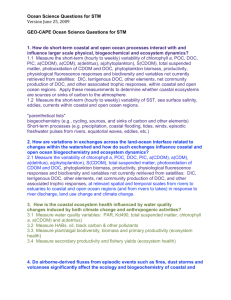References - Optical Oceanography Laboratory
advertisement
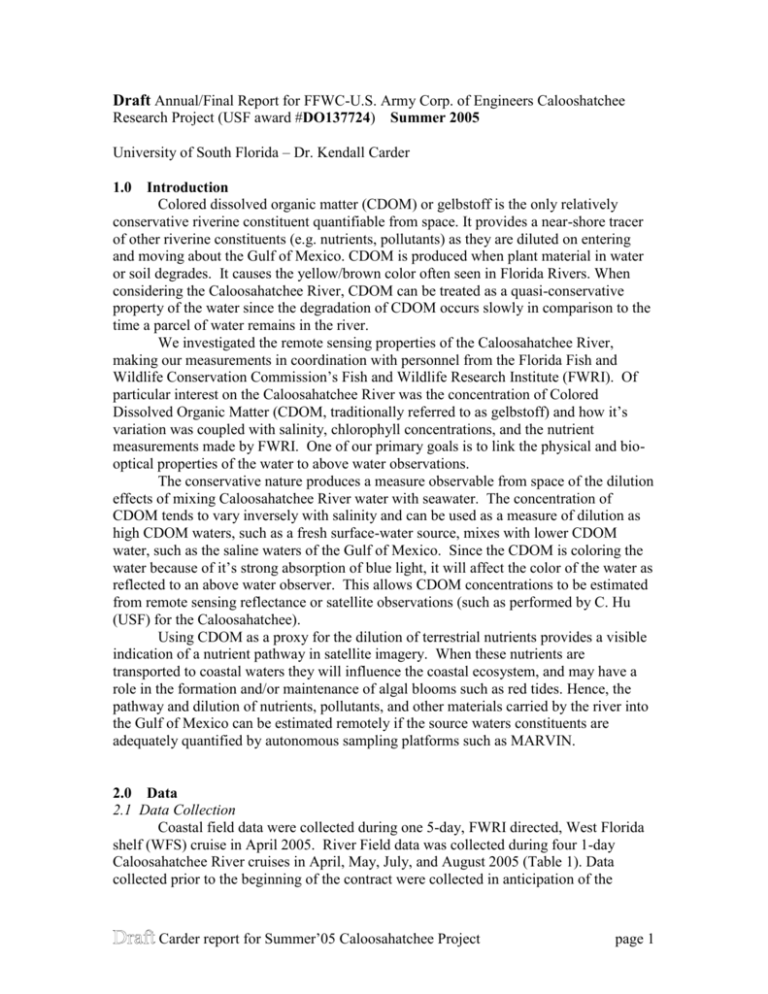
Draft Annual/Final Report for FFWC-U.S. Army Corp. of Engineers Calooshatchee Research Project (USF award #DO137724) Summer 2005 University of South Florida – Dr. Kendall Carder 1.0 Introduction Colored dissolved organic matter (CDOM) or gelbstoff is the only relatively conservative riverine constituent quantifiable from space. It provides a near-shore tracer of other riverine constituents (e.g. nutrients, pollutants) as they are diluted on entering and moving about the Gulf of Mexico. CDOM is produced when plant material in water or soil degrades. It causes the yellow/brown color often seen in Florida Rivers. When considering the Caloosahatchee River, CDOM can be treated as a quasi-conservative property of the water since the degradation of CDOM occurs slowly in comparison to the time a parcel of water remains in the river. We investigated the remote sensing properties of the Caloosahatchee River, making our measurements in coordination with personnel from the Florida Fish and Wildlife Conservation Commission’s Fish and Wildlife Research Institute (FWRI). Of particular interest on the Caloosahatchee River was the concentration of Colored Dissolved Organic Matter (CDOM, traditionally referred to as gelbstoff) and how it’s variation was coupled with salinity, chlorophyll concentrations, and the nutrient measurements made by FWRI. One of our primary goals is to link the physical and biooptical properties of the water to above water observations. The conservative nature produces a measure observable from space of the dilution effects of mixing Caloosahatchee River water with seawater. The concentration of CDOM tends to vary inversely with salinity and can be used as a measure of dilution as high CDOM waters, such as a fresh surface-water source, mixes with lower CDOM water, such as the saline waters of the Gulf of Mexico. Since the CDOM is coloring the water because of it’s strong absorption of blue light, it will affect the color of the water as reflected to an above water observer. This allows CDOM concentrations to be estimated from remote sensing reflectance or satellite observations (such as performed by C. Hu (USF) for the Caloosahatchee). Using CDOM as a proxy for the dilution of terrestrial nutrients provides a visible indication of a nutrient pathway in satellite imagery. When these nutrients are transported to coastal waters they will influence the coastal ecosystem, and may have a role in the formation and/or maintenance of algal blooms such as red tides. Hence, the pathway and dilution of nutrients, pollutants, and other materials carried by the river into the Gulf of Mexico can be estimated remotely if the source waters constituents are adequately quantified by autonomous sampling platforms such as MARVIN. 2.0 Data 2.1 Data Collection Coastal field data were collected during one 5-day, FWRI directed, West Florida shelf (WFS) cruise in April 2005. River Field data was collected during four 1-day Caloosahatchee River cruises in April, May, July, and August 2005 (Table 1). Data collected prior to the beginning of the contract were collected in anticipation of the Carder report for Summer’05 Caloosahatchee Project page 1 proposal being funded. The contract period encompassed only the processing and analysis of these data. One of the stations visited during the Caloosahatchee River sampling was the FWRI’s MARVIN (MERHAB autonomous research vessel in situ sampler) sampling platform. A description of the MARVIN program can be found at http://www.merhabflorida.org/marvin.htm. In August 2005 we added a CDOM fluorometer (WETLabs CDOM_WETStar) to the MARVIN sampling system. The information from this fluorometer is integrated into the MARVIN data stream and an initial time series is being generated. Since the instrument only became available for integration in August, a preliminary calibration using lab and comparisons with other field instruments is being used until more calibration and validation measurements of CDOM can be made at the MARVIN station on the Caloosahatchee. 2.1.1 WFS cruise Between April 25th and 29th surface water measurements were collected from the R/V Suncoaster during a FWRI expedition which ranged from Tampa Bay (~27.7oN) to the Florida Keys (~25oN) and from ~5 to 50km offshore (Fig. 1). Data collected include remote-sensing reflectance spectra, Rrs(), (n=15) and spectral light absorption (n=42) due to total particles, ap(), detritus, ad(), and gelbstoff, ag() (Fig. 2). Chlorophyll a concentrations were determined at each station and ranged from 0.26-3.6 mg m-3 (n=42). Surface underway measurements of temperature, salinity, beam-attenuation, chlorophyll and gelbstoff fluorescence, and backscattering were also collected using a deck-mounted, flow-through system (Fig. 3). 2.1.2 Caloosahatchee River cruises We accompanied FWRI personnel during Caloosahatchee River sampling and MARVIN maintenance field work from the mouth of the river upstream to Franklin Locks (Fig. 1). During these journeys along the river Rrs() measurements were made from the boat and ap(), ad(), ag(), and [Chl a] data were measured from discrete surface seawater samples taken at the FWRI sampling stations (Fig. 4). Vertical profiles of temperature, salinity, chlorophyll, and gelbstoff fluorescence were also collected at these stations and the data were later processed into discrete depth ranges to aid interpretation. The profiles were collected at <0.2 m intervals by slowly lowering and raising an instrument frame containing an FSI 2”microCTD, a WETLabs Chl. WETStar fluorometer, and a WETLabs Flashlamp CDOM fluorometer. Example profiles from three stations are shown in Fig. 5. The Sanibel station is located near the mouth of the Caloosahatchee, the West Redfish Pass station is downriver from Fort Meyer near Cape Coral, and the MARVIN station is near Beautiful Island and the Orange River. The variability of CDOM along the river, and between sampling trips can be seen in Figure 6. This figure shows vertical profiles of ag(440) taken at different times at the Caloosahatchee sampling locations. 2.1.3 Caloosahatchee River gelbstoff fluorescence time-series On 18 August 2005, a WETLabs WETStar CDOM fluorometer (excitation at 370nm with emission measured between 400to 520nm) was integrated into the MARVIN data-sampling regime. Water was collected every hour from two depths (near surface Carder report for Summer’05 Caloosahatchee Project page 2 and ~ 4m) to allow the MARVIN instruments to measure salinity, temperature, chl_a. fluoresence, pH, dissolved oxygen, turbidity, water level, and other meteorological variables. This information is stored on the platform and also transmitted back to a data archive and online display system at FWRI. Fluorometer voltages were converted to preliminary ag(400) estimates based on several laboratory and field measurements. Figure 7 shows a one-week time-series of these preliminary ag(400) values from the autonomous MARVIN measurements. Since CDOM fluorescence efficiency varies due to changes in water source, light exposure, and other factors, continued validation measurements are desired to separate CDOM variability from changing seasonal fluorescence or instrument efficiencies. 2.2 Data Processing Absorption spectra due to particles and detritus (ap() and ad()), were determined using the quantitative filter technique (Yentsch, 1962; Kiefer & SooHoo, 1982). Measurements were made with a custom-made, 512-channel spectroradiometer (~350850nm, ~2.5nm resolution). Pigments were extracted with hot methanol (Kishino et al., 1985; Roesler et al., 1989) from which chlorophyll a concentrations were determined fluorometrically (Holm-Hansen & Riemann, 1978). Phytoplankton absorption spectra, aph(), were then calculated as the difference between ap() and ad(). Gelbstoff absorption spectra, ag(), were measured on 0.2m filtered surface seawater samples using a dual-beam spectrophotometer (Perkin-Elmer® Lambda 18). Data were processed using methods previously described by Mueller and Fargion (2002). Remote-sensing reflectance spectra, Rrs(), were determined from the ratio of water leaving radiance, Lw(), to downwelling irradiance, Ed(). Lw() and Ed() were calculated from above-water measurements of upwelling radiance, sky radiance, and the radiance reflected from a near-Lambertian greycard (Spectralon; ~10%) using methods described previously by Lee et al. (1997). All measurements were made using a custommade, 512-channel spectroradiometer (~350-850nm; ~2.5nm resolution). CDOM and chlorophyll fluorescence measurements were converted to absorption and chlorophyll concentrations by comparing the instrument measurements to the discrete measurements made that day on the appropriate portion of the river. The fluorescence profiles were then binned into 0.5m increments using medians. 2.3 Data Analysis Coastal observations, made offshore of the Caloosahatchee mouth during FWRI’s April expedition, were processed to produce measurements of in-water optical properties, chlorophyll and gelbstoff concentrations, and remote sensing spectra. Water samples taken from four trips (occurring from April to August), each with several stations along the Caloosahatchee river, were processed to yield absorption spectra and chlorophyll and gelbstoff concentrations. In addition, remote sensing spectra and vertical profiles of temperature, salinity, chlorophyll, and CDOM were derived from the small boat measurements. The status of the data processing and analysis is presented in Table 2. Though funding and procurement constraints delayed the installation of a CDOM fluorometer onto the MARVIN platform until August 18, an initial time series of CDOM variability has been generated (Fig. 7). An immediate result of this series is showing that not only is CDOM variable over several days, but that there is a circadian variability Carder report for Summer’05 Caloosahatchee Project page 3 pattern. This diel variability may not only be affected by the sun, but also pH and river flow. Since this station is located where much of the Caloosahatchee source water is entering the estuary, and since it does show diel variability, it suggests that some of the variability in CDOM fluorescence measurements taken downstream (Fig. 8) may be explained by the time of day at which individual samples were taken. The CDOM measurements were compared to salinity and a significant linear relationship was derived for each river sampling day samples. This relationship was most robust for April and May, but in July the variability of the CDOM at the upriver stations ( Franklin Locks, MARVIN, Fort Meyers) decreased the strength of a straight line fit to these measurements. A different water source will also cause samples to diverge from a linear relationship. Note in Figure 6 how the Franklin Lock CDOM absorption profiles in May and July have smaller values than the MARVIN profiles. This is probably because the locks are upstream of the Orange River, which enters into the Caloosahatchee just upstream of the MARVIN site. The profiles produced at each station along the river (e.g. Fig 5) not only provide a means of interpolating our discrete samples, but also provide information about the vertical structure of the river and the location of the mixing boundary of the gulf and river water. Though the scales are varied in Figure 5 to clarify the vertical structure, it is evident that on this day in May the tidal excursion of the more saline Gulf water below the fresher, warmer, high gelbstoff river water does not extend as far upstream as the MARVIN site. In fact, the MARVIN site shows weak vertical structure. It should also be noted that the CDOM absorption does not necessarily co-vary with chlorophyll concentrations at all stations. Variability of the flow rate of surface water into the Caloosahatchee will have a strong effect on physical and biological structure of the river. A plot of flow measurements made near Lake Okeechobee and at the most downstream lock along the river (Franklin Lock) is shown if Figure 9. Combining the flow rate observations with the autonomous MARVIN observations and the river profiles is not yet complete. 3.0 Discussion and Future work The relationship between CDOM and other conservative properties (such as salinity) should be robust in a steady-state coastal estuary with only a constant single source of fresh water. The Caloosahatchee is not a steady-state system, nor is there a constant single source of water. We also see from the measurements described in this report that CDOM concentrations are variable, even at upper estuary sites like MARVIN. Despite this, the relationship between CDOM concentration and salinity has been shown to be robust during sampling periods of a day. Thus, the remotely observable CDOM absorption ( such as C. Hu’s work on satellite observations of the Caloosahatchee outflow) should be a useful indicator of the distribution of Caloosahatchee water into the Gulf of Mexico and may serve as visible proxy for other slowly changing nutrients or material. Furthermore, the deflections of measured CDOM concentrations from a linear prediction of their values can provide information about the input of water from other sources into the Caloosahatchee. We can see in Figure 9 that not all the water flowing downstream into the Caloosahatchee estuary comes from Lake Okeechobee. In addition to variations in the amount of water released from Lake Okeechobee, this Southern Florida region received Carder report for Summer’05 Caloosahatchee Project page 4 considerable rain from multiple tropical storms or hurricanes in the last year. During the anticipated continuation of the Caloosahatchee study we intend to further examine the variability of CDOM concentration and fluorescence, recognizing that this estuary will have multiple water sources whose contributions may vary considerably throughout any particular year. Since the CDOM fluorometer is now installed on MARVIN, a time series beyond the one-week’s measurements presented here can be started. Combining a longer time series with river flow measurements should not only help determine seasonal and flowrate dependant CDOM concentration variability, but also provide information about the range and timing of daily CDOM fluorescence variability. Calibration and validation measurements throughout the year will be needed to establish the accuracy of the instrument, account for seasonal fluorescence efficiency variability, and provide alerts for instrument degradation. We hope to continue to provide these measurements during subsequent installments of this project. Since our measurements show CDOM concentrations on the river can vary over 100%, and even can vary almost 20% during a day, continued measurements of CDOM concentration will be needed to accurately interpret remotely sensed color data. The initial measurements in the Caloosahatchee suggest that CDOM concentration may be a useful indicator for the mixing and dilution of upstream Caloosahatchee water and slowly changing material in the water. This CDOM dilution should continue offshore where it should indicate the dilution and transport of riverine nutrients through coastal waters. We hope to continue our efforts to refine the ability to determine bio-optical properties of WFS waters from above-water measurements, and so to provide a remote sensing indicator of the route and planktonic consequences of riverine input to the coastal ecosystem. References Holm-Hansen, O. & Riemann, B. (1978), Chlorophyll a determination: improvements in methodology. Oikos, 30, 438-447. Kiefer, D.A. & SooHoo, J.B. (1982), Spectral absorption by marine particles of coastal waters of Baja California. Limnol. Oceanogr., 27, 492-499. Kishino, M., Takahashi, M., Okami, N., & Ichimura, S. (1985), Estimation of the spectral absorption coefficients of phytoplankton in the sea. Bull. Mar. Sci., 37, 634-642. Lee, Z., Carder, K.L., Steward, R.G., Peacock, T.G., Davis, C.O., et al. (1997), Remote-sensing reflectance and inherent optical properties of oceanic waters derived from above-water measurements. In: Ackleson, S.G., & Frouin, R. (Eds.), Ocean Optics XIII, SPIE 2963, Halifax, Nova Scotia, Canada, pp. 1960-1966. Mueller, J.L. & Fargion, G.S. (2002), Ocean optics protocols for satellite ocean color sensor validation, revision 3, volume 2. NASA Tech. Memo. 2002-210004/Rev3-Vol2, NASA Goddard Space Flight Center, Greenbelt, Maryland. Roesler, C.S., Perry, M.J., & Carder, K.L. (1989), Modeling in situ phytoplankton absorption from total absorption spectra in productive inland marine waters. Limnol. Oceanogr., 34, 1510-1523. Yentsch, C.S. (1962), Measurement of visible light absorption by particulate matter in the ocean. Limnol. Oceanogr., 7, 207-217. Carder report for Summer’05 Caloosahatchee Project page 5 Table 1. USF-Carder 2005 field activity summary with the number of samples collected for each measurement and cruise. Location Month Rrs() ap() ad() ag() [Chl a] in situ April 15 42 42 42 42 Surface underwaya April Caloosahatchee May River July August 7 6 6 7 6 7 6 7 6 7 6 7 6 7 6 7 6 7 6 7 Vertical profilesb Offshore a Surface underway measurements were taken of temperature, salinity, beam-attenuation, chlorophyll and gelbstoff fluorescence, and particulate backscattering. b Vertical profile measurements were taken of temperature, salinity, and chlorophyll and gelbstoff fluorescence. Table 2. USF-Carder 2005 field data status. Location Month Collected Processed WFS April X X April X X X X Caloosahatchee May River July X X August X - Analysed Preliminary Preliminary Preliminary Preliminary - Carder report for Summer’05 Caloosahatchee Project page 6 Figure 1. Map of station locations for the WFS and Caloosahatchee River cruises. Figure 2. West Florida shelf remote-sensing reflectance spectra, phytoplankton absorption spectra, detrital absorption spectra, and gelbstoff absorption spectra collected between 25-29 April 2005 aboard the R/V Suncoaster. Carder report for Summer’05 Caloosahatchee Project page 7 28 Sea Surface Temperature (deg. C) Salinity (psu) 27.5 Latitude (deg. N) 27 26.5 26 25.5 25 20 24.5 83.5 24 83 28 82.5 82 32 81.5 36 81 80.5 21 80 83.5 23 83 82.5 Longitude (deg. W) 25 82 27 81.5 81 80.5 80 Longitude (deg. W) 28 Chlorophyll a Concentration (mg/m^3) 27.5 ag(400) (1/m) Latitude (deg. N) 27 26.5 26 25.5 25 0.1 24.5 83.5 1 83 82.5 82 0.01 10 81.5 81 80.5 80 83.5 83 0.1 82.5 Longitude (deg. W) 82 1 81.5 10 81 80.5 80 Longitude (deg. W) Figure 3. Distribution of salinity, sea surface temperature, chlorophyll a concentration, and ag(400) measured during the April 2005 west Florida shelf cruise. Carder report for Summer’05 Caloosahatchee Project page 8 Figure 4. Caloosahatchee River remote-sensing reflectance spectra, particle absorption spectra, detrital absorption spectra, and gelbstoff absorption spectra collected 14 April, 12 May, 21 July, and 18 August. Carder report for Summer’05 Caloosahatchee Project page 9 FWRI station 1, near Sanibel Island 12 May 2005 0 0 0 0 1 1 1 1 2 2 2 2 3 3 3 3 4 4 4 4 5 0.38 0.40 0.42 0.44 0.46 0.48 0.50 0.52 5 5 5 32.6 25.8 25.9 26.0 26.1 26.2 26.3 32.8 33.0 Temperature (°C) Depth 33.4 1.7 0.0 0.0 0.0 0.5 0.5 0.5 0.5 1.0 1.0 1.0 1.0 1.5 1.5 1.5 2.0 2.0 2.0 2.0 2.5 2.5 2.5 2.5 3.0 3.0 6 26.6 26.8 27.0 27.2 27.4 27.6 27.8 8 10 Temperature (°C) 12 14 16 18 20 0 1 1 2 2 3 3 4 4 Temperature (°C) 2.1 2.2 2.3 3.0 5C: 5 0.220 ag(440) (m-1) FWRI station 6, MARVIN 0 0.224 Salinity 0.228 6 1 2 2 3 3 4 4 4.2 4.3 ag(440) (m-1) 10 12 14 16 18 20 22 0 1 4.1 8 Chl. Fluoresence (~g l-1) 5 26.5 27.0 27.5 28.0 28.5 29.0 2.0 1.5 2.0 2.2 2.4 2.6 2.8 3.0 3.2 3.4 3.6 Salinity 0 5 1.9 FWRI station 4, West of Redfish Pass 0.0 3.0 1.8 Chl. Fluoresence (~g l-1) ag(440) (m-1) Salinity 5B: Depth 33.2 Depth Depth 5A: 4.4 5 10.010.511.011.512.012.513.013.5 Chl. Fluoresence (~g l-1) Figure 5. Example profiles of temperature, salinity, a g(400), and Chl_a fluoresence for 3 stations on the Caloosahatchee River on 12 May 2005. 5A: near the southern tip of Sanibel Island and shows the river flowing into (and above) Gulf of Mexico waters. 5B: West of Redfish Pass, downstream of both Cape Coral and Fort Meyer and shows the tidal intrusion of the Gulf waters below the fresher Caloosahatchee water. 5C: shows a profile from the MARVIN site. Carder report for Summer’05 Caloosahatchee Project page 10 Gelbstoff (CDOM) absorption 14 April 2005 0 Depth (m) 1 2 3 4 5 6 7 Depth (m) 0 2 3 4 5 6 12 May 2005 0 1 2 3 4 5 6 7 near Sanibel San Carlos Matlacha W. Redfish Pass Fort Meyer Marvin Franklin Locks 0 Depth (m) 1 1 2 3 4 5 6 10 12 21 July 2005 0 1 2 3 4 5 6 7 0 2 4 6 -1 Ag(440) (m ) 8 Figure 6. Blue absorption due to gelbstoff on three days. Note that the scale of the absorption axis for the July samples is twice that of the April and May samples. The amount of water flowing downstream in July was also significantly greater than the volume for the previous months. Carder report for Summer’05 Caloosahatchee Project page 11 Estimated CDOM absorption at MARVIN from integrated CDM fluorometer ag(400) (m-1) [preliminary calibration] 18 16 14 12 10 8 6 4 preliminary ag(400) at MARVIN surface preliminary ag(400) at MARVIN bottom 2 0 8/19/05 8/20/05 8/21/05 8/22/05 8/23/05 8/24/05 8/25/05 time (m/d/y hour) Figure 7. Preliminary CDOM absorption time series from the gelbstuf fluorometer installed on MARVIN on August 18th. Note that there was no significant difference between the values at the surface and at depth, which is to be expected since this site shows little vertical structure (Fig. 5C). However, this initial series does show circadian variablity which indicates that sampling times should be considered during further analysis of CDOM concentrations along the river. Carder report for Summer’05 Caloosahatchee Project page 12 Figure 8. Relationship between gelbstoff absorption at 400nm and salinity for the WFS (April) and Caloosahatchee River (April, May, and July) cruises. Carder report for Summer’05 Caloosahatchee Project page 13 600 20 15 10 5 Mean Daily Flow m3 s-1 Mean Daily Rain Fall (cm day-1) 25 500 Lock 79 at Franklin Lock Lock 77 at Lake Okeechobee Mean Daily Rain E. Calooshatchee Basin 400 300 200 100 0 0 -100 08/01/04 12/01/04 04/01/05 08/01/05 Date Figure 9. Caloosahatchee River flow rate and rainfall as measured along the River by the U.S. Army Corp of Engineers and retrieved from the South Florida Water Management District (SFWMD) database. Lock 79 is Franklin Lock and is located just upstream of this Caloosahatchee Estuary study area. Carder report for Summer’05 Caloosahatchee Project page 14
